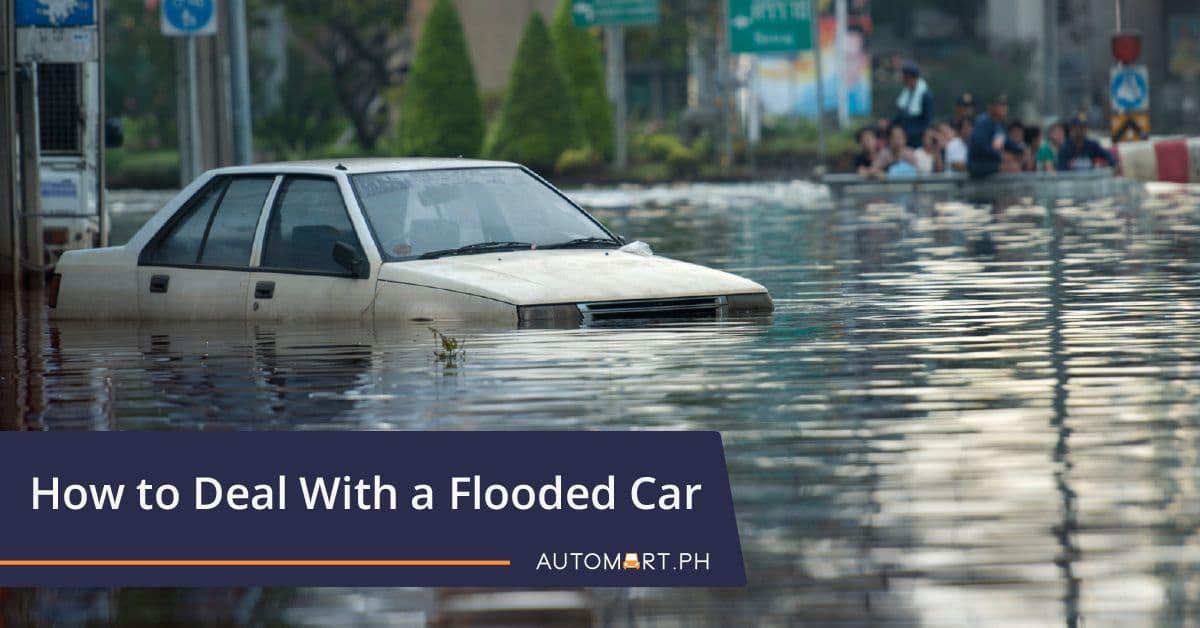
How to Deal With a Flooded Car
Updated on December 18 2025
There is an old saying that when it rains, it pours. But here in the Philippines, floods will usually accompany heavy rains, and it doesn’t matter if the rains came via freaky monsoon weather or fearsome storms.

And when heavy flooding arrives – and it usually arrives suddenly and in full force – there is little you can do to protect your vehicle from imminent flood damage.
However, all is not lost. Here are the first things you can do if your precious car gets flooded.
1. Stay calm, grab your smartphone, and take pictures.
Instead of pulling your hair and swearing to the high heavens, it’s better to grab your smartphone and take images or video clips of the vehicle submerged in flood. It may sound counterintuitive, but you’re doing it for insurance purposes – you do have auto insurance, right?
Remember that your comprehensive auto insurance will generally cover flood damage. The insurance provider will appreciate it if you have proof of the vehicle submerged in flood.
2. Determine how deep the vehicle was submerged.
There’s a reason why you should take images or video clips of your flooded car: it helps the insurance provider determine the extent of the damage. Insurance companies will typically classify a flooded vehicle as “totaled” or “total damage” if the water reaches the bottom of the dashboard.
3. Call your insurance provider.
It’s better to get a head start before the insurance company gets, umm, “flooded” or inundated with claims. Call your insurance provider and give them an update on the situation as soon as possible.
4. Do not start the engine.
Never attempt to start a flooded car. Unless the floodwaters only reached the bottom of the doors, it’s not a good idea to start the engine and see how it goes. There are other things you can do besides gambling with a flooded engine.
5. Disconnect the battery.
This one is a better idea. A modern vehicle is essentially a mishmash of computers and sensitive electrical circuits like fuses, relays, and fusible links. Instead of starting the engine, it’s better to open the hood and disconnect the battery to prevent electrical shorts.
And since water and electricity don’t go well like French fries and catsup, disconnecting the battery prevents more expensive problems from cropping up later on.
Tip: If possible, disconnecting the battery cables before the floodwaters rise is a stellar idea.
6. Dry the interior.
Here in the Philippines, floodwaters will come with other nasty things like trash and thick mud, further heightening the challenge of cleaning a flooded car. After the water and rains have subsided, the least you can do is to open the doors and allow the cabin to air out.

And while you’re at it, it’s best to remove the floor mats, seats, and carpets. If your vehicle was fully submerged, you might need to remove the headliner, as well.
7. Have the car towed to the nearest service center.
At this point, the next course of action is to have your vehicle towed to the nearest dealership or service center. The dealership can communicate with your insurance provider in relaying the actual condition of your car.
The floods were not that deep. What should I do?
If the floods were not deep enough (or if the water level was only below the bottom of the doors), consider yourself lucky. Still, there are certain things to check before attempting to start your car.
- Open the doors and check if the carpets are wet. If not, you’re in the clear. If yes, remove the carpets and dry everything out before starting the car. Consider using a dehumidifier to rid the interior of excess moisture.
- Open the hood and check the engine bay. Remove any trash or debris around or under the engine bay, especially around the fan shrouds and drive belts.
- Pull out the dipstick and check the engine oil. If you find water droplets in the dipstick, there is probably water inside the engine. If that’s the case, drain the oil, replace the oil filter, and refill the crankcase with fresh engine oil.
- Pull out the automatic transmission dipstick to check the ATF or automatic transmission fluid. Fresh ATF should be reddish or pinkish and should have a somewhat sweet smell. If the ATF mixes with water, you should flush it out and refill as necessary.
- Check the engine air filter. If the air filter is wet, it probably means there is water inside the engine. Otherwise, replace the air filter if necessary before attempting to start the engine.
If everything is clear, you may proceed to start the car. After starting the engine, allow the engine to warm up and do the following:
- Perform a complete walkaround of the car. Check for any trash or debris that may dislodge on the wheels, brakes, wheel bearings, undercarriage, and exhaust tips.
- Turn on the headlights and check if all the bulbs are working.
- Watch for the check engine light. If it turns on, you may need to bring the car to a mechanic. If not, you’re all good.
- Drive the vehicle slowly to dry the brakes. Avoid sudden acceleration for the first few kilometers until the brakes are dry.
Conclusion
Why wait for rising floodwaters? If you have a car and live in flood-prone areas, consider getting comprehensive auto insurance (with acts of nature coverage) to protect your assets from flooding and other natural calamities. If you don’t have auto insurance, now is the best time to get a policy.